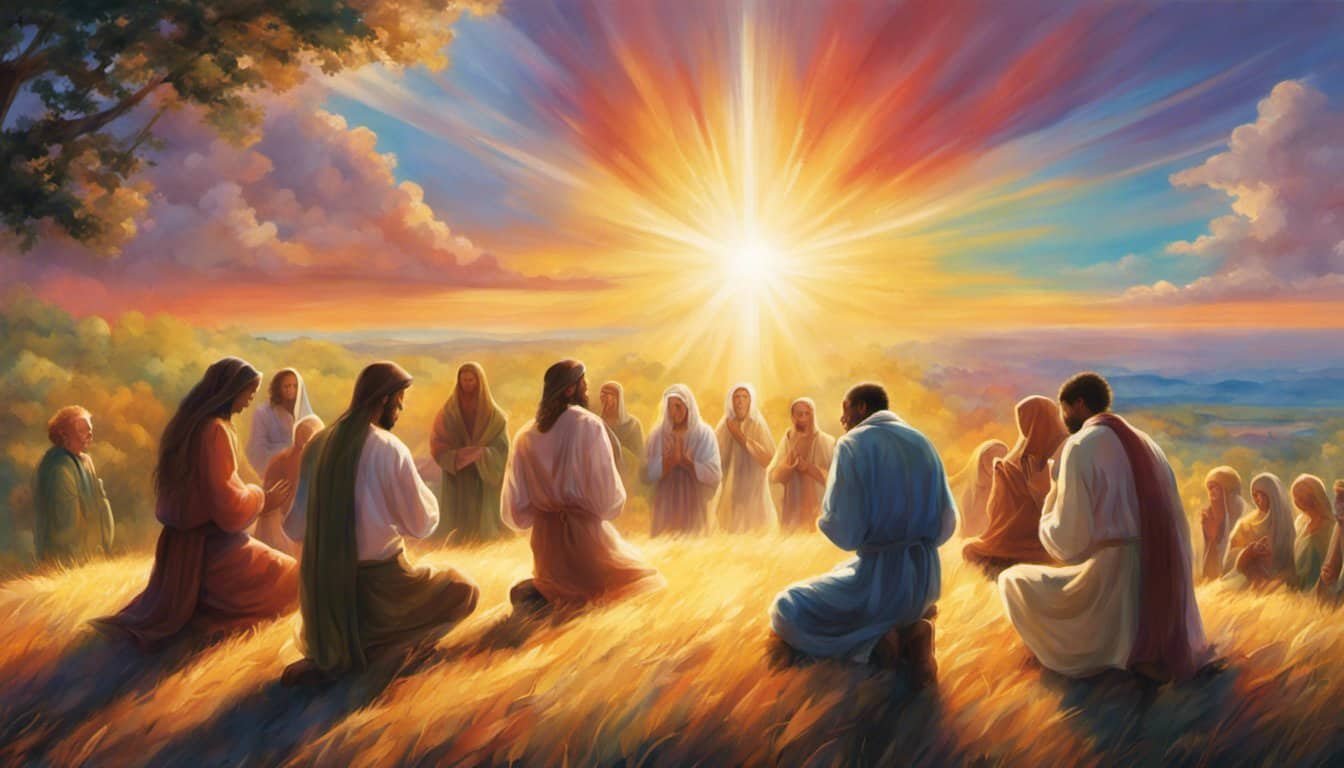When people think about the Old Testament, they often associate it with Christianity. But did you know that it’s also a central part of Jewish tradition? The Old Testament, known in Judaism as the Tanakh, forms the foundation of Jewish religious texts and teachings.
I’ve always been fascinated by how different religions share common roots, yet interpret them uniquely. In Judaism, the Tanakh isn’t just a historical document; it’s a living guide that shapes daily practices, holidays, and moral principles. So, let’s dive into how Jews use the Old Testament and what it means in their faith.
Understanding the Jewish Scriptures

Jewish scriptures, mainly the Hebrew Bible, form the cornerstone of Jewish religious life and practice. Let’s delve into the various components and their significance.
What Is the Old Testament?
The Old Testament is a major part of the Christian Bible, composed of sacred scriptures that Christians and Jews alike hold in high regard. For Jews, though, it’s called the Tanakh. The name “Old Testament” is specific to Christians, but the content overlaps significantly with what Jews refer to as their holy books.
Relationship to the Tanakh and Torah

The Tanakh comprises the Torah (Law), Nevi’im (Prophets), and Ketuvim (Writings). These texts together make up what Christians know as the Old Testament. The Torah, specifically, includes the first five books: Genesis, Exodus, Leviticus, Numbers, and Deuteronomy.
Jews don’t perceive their scriptures as “old” or “new”; for them, the Tanakh is timeless and continually relevant. It dictates their laws, ethical teachings, and day-to-day practices. For example, the Ten Commandments, found in the Torah, guide both moral behavior and communal rules.
Understanding Jewish scriptures gives insight into common roots shared with Christianity, while also respecting and appreciating distinct interpretations and traditions within Judaism. This foundation enriches one’s perception of these profound texts.
Historical Context of Jewish Scriptures
Understanding the historical context of Jewish scriptures sheds light on their timeless relevance and continued influence on Jewish life and practice. Let’s delve into how these sacred texts originated and evolved.
Origins and Development of the Texts
Jewish scriptures trace their origins back thousands of years. The Tanakh, the Hebrew Bible, consists of three parts: Torah (Law), Nevi’im (Prophets), and Ketuvim (Writings).
- Torah: Also known as the Pentateuch, the Torah includes the first five books: Genesis, Exodus, Leviticus, Numbers, and Deuteronomy. These books lay the foundation of Jewish law and tradition, documenting the creation of the world, the patriarchs, and the exodus from Egypt.
- Nevi’im: This section comprises historical and prophetic books. Books like Joshua and Judges recount the history of Israel, while Isaiah and Jeremiah feature prophecies addressing the moral and spiritual state of the nation.
- Ketuvim: The Writings include a diverse collection ranging from poetry and philosophy to historical chronicles. Psalms, Proverbs, and Ecclesiastes are among the notable books, offering wisdom, hymns, and reflections on life.
The scriptures were developed over centuries, with texts being orally transmitted before being written down. Scholars believe the final compilation of the Tanakh happened in the early centuries CE, solidifying its structure and canon.
The Role of the Prophets
Prophets played a crucial role in the development and dissemination of Jewish scriptures. They were not just predictors of the future but were seen as God’s messengers. Here’s how they contributed:
- Moral and Ethical Guidance: Prophets like Isaiah, Jeremiah, and Ezekiel delivered messages that emphasized justice, compassion, and adherence to divine laws. They called out the moral failures of the people and leaders, urging repentance and reform.
- Historical Contexts: Some prophets gave insights into the historical events of their times. For example, the books of Isaiah and Jeremiah provide context for the Babylonian exile, shedding light on the social and political upheavals faced by the Jewish people.
- Expansion of Jewish Theology: Prophetic books expanded on existing theological concepts, introducing ideas about the nature of God, the covenant, and the future of Israel. They enriched and deepened the spiritual landscape of Judaism, influencing future generations’ beliefs and practices.
By examining the origins and roles of these texts and figures, one can appreciate the depth and continuity of the Jewish faith, as seen through its sacred scriptures.
Modern Use of the Old Testament in Judaism
Jews continue to value the Old Testament, or Tanakh, in their religious and cultural practices today. The rich traditions and deeply rooted beliefs from centuries ago still shape their daily lives.
Religious Practices and Readings
In Jewish communities, the Tanakh plays a crucial role in religious rituals and ceremonies. They read from the Torah, which is the first five books of the Tanakh, during weekly Shabbat services. Specific portions, known as parashot, are read in a yearly cycle, ensuring that the entire Torah is covered each year. This practice not only helps maintain a strong connection to their religious texts but also fosters a sense of unity among members.

During holidays like Passover and Yom Kippur, Jews also turn to the Tanakh for guidance. For instance, during Passover, they recite the story of the Exodus from Egypt, which comes from the Book of Exodus in the Torah. This story reminds them of their ancestors’ struggles and God’s deliverance, emphasizing themes of liberation and faith.
Interpretations and Teachings
Rabbis and scholars have interpreted the Tanakh in various ways over the centuries, providing a rich tapestry of teachings that guide modern Jewish thought. The Talmud, a central text in Rabbinic Judaism, contains extensive commentary on the Torah and other parts of the Tanakh, offering insights into their meanings and applications.
In contemporary times, Jews study these interpretations in yeshivas (Jewish educational institutions) and synagogues. They often engage in discussion-based learning, known as chevruta, where pairs of students analyze and debate passages from the Tanakh and Talmud. This interactive method encourages deep understanding and personal connection to the texts.
Furthermore, Jews use the Tanakh to draw moral and ethical lessons that apply to modern life. They might reflect on the stories of the prophets to understand justice, compassion, and social responsibility. For example, the teachings of the Prophet Isaiah, who emphasized social justice and care for the oppressed, continue to inspire Jewish social action initiatives today.
The Old Testament’s presence in modern Judaism manifests through regular readings during religious ceremonies, extensive study and interpretation, and the application of its teachings to contemporary moral and ethical questions. This ongoing engagement with the Tanakh ensures that its ancient wisdom remains relevant and influential in the lives of Jews around the world.
Hey there! I’m Adam Phillips, your friendly youth pastor with over two decades of experience. Today, I want to share some practical advice and insights from my extensive Bible knowledge. Whether you’re looking for encouragement, wanting to deepen your faith, or just curious about the Good Book, you’re in the right place. Let’s get started.
Comparative Analysis
Why’s the Bible important? Well, it’s our go-to guide for life. The Bible provides wisdom, guidance, and comfort to many. It’s not just a book; it’s an anchor for our faith. Plus, it helps us understand God’s will and how we can live it out daily.
Step-by-Step Tutorials: How to Study the Bible
Studying the Bible can seem daunting. So, I’ve broken it down into manageable steps to make it easier for you.
Step 1: Choose the Right Bible
First, find a Bible that suits you. There are tons of translations out there like the NIV, KJV, and ESV. Pick one that’s easy for you to read and understand. A study Bible is also a great option since it offers notes and explanations.
Step 2: Find a Quiet Spot
Choose a quiet place where you can focus. Got a favorite chair or a cozy corner? Perfect. Make it your Bible study nook.
Step 3: Start with Prayer

Before diving into the scriptures, take a few moments to pray. Ask God to open your heart and mind to His Word. Prayer sets the tone and keeps you connected to the Holy Spirit.
Step 4: Read and Reflect
Read a passage, then pause to reflect on its meaning. What is the passage saying? How does it apply to your life now? Take your time; there’s no rush.
Step 5: Take Notes
Write down your thoughts, questions, and any verses that stand out to you. Journaling helps you remember what you’ve learned and track your spiritual growth.
Step 6: Apply the Word
Think about how you can apply what you’ve learned. Maybe the scripture encourages you to be more patient or to help someone in need. Put the Word into action.
Step 7: Discuss with Others
Talk about what you’ve read with friends or a study group. Sharing insights and hearing other perspectives can deepen your understanding.
Reviewing Popular Bible Study Tools

You might wonder what tools can help you on your Bible study journey. Here are a few I recommend:
- YouVersion Bible App: It’s free and offers tons of reading plans. You can compare different translations and even listen to audio versions.
- Blue Letter Bible: Great for in-depth study. It includes commentaries, dictionaries, and more.
- Bible Gateway: Another comprehensive resource. It offers various translations, devotionals, and study tools.
Tips for Consistent Bible Study
Conclusion
The Old Testament, or Tanakh, is undeniably central to Jewish life, guiding both religious and everyday practices. Its teachings continue to shape Jewish laws, ethics, and cultural traditions. Whether through rituals, holidays, or daily reflections, the Tanakh remains a vital part of Judaism.
Exploring these scriptures offers a deeper understanding of Jewish heritage and faith. The wisdom passed down through generations by rabbis and scholars enriches this journey. For those looking to delve into their own spiritual study, the practical advice and tools shared by a youth pastor can make the process more approachable and meaningful.
So, whether you’re studying alone or with a group, remember that engaging with these ancient texts can be a deeply rewarding experience, offering insights that resonate across time and culture.
Frequently Asked Questions
What is the Old Testament in Judaism?
The Old Testament, also known as the Tanakh, is a foundational text in Judaism. It includes the Torah (Law), Nevi’im (Prophets), and Ketuvim (Writings), which together shape Jewish laws, ethics, and daily practices.
Why is the Old Testament important in Jewish tradition?

The Old Testament is crucial in Jewish tradition as it lays the foundation for religious rituals, moral principles, and cultural practices, influencing all aspects of Jewish life and worship.
How does the Old Testament affect daily Jewish practices?
The Old Testament guides daily Jewish practices by offering laws and moral principles that dictate behavior, rituals, and ethical decisions in both personal and communal life.
What are the main sections of the Old Testament?
The main sections of the Old Testament are the Torah (the first five books), Nevi’im (Prophets), and Ketuvim (Writings), each serving a distinct role in conveying Jewish history, laws, and teachings.
How is the Old Testament used in modern Judaism?
In modern Judaism, the Old Testament is used in religious services, ceremonies, and holidays. It is studied continuously, with rabbis and scholars interpreting its texts to apply its teachings to contemporary life.
What is the Torah?
The Torah is the first section of the Old Testament and comprises the first five books, which include fundamental laws, commandments, and teachings central to Jewish faith and practice.
Who interprets the Old Testament in Judaism?

Rabbis and scholars have historically interpreted the Old Testament, offering insights and explanations that help the Jewish community understand and apply its teachings to everyday life.
How can one start studying the Bible effectively?
Start by choosing the right Bible, find a quiet spot, begin with prayer, read and reflect on passages, take notes, apply the teachings, and discuss them with others. Consistency and the use of study tools can also enhance your study.
What are some popular Bible study tools?
Popular Bible study tools include commentaries, study guides, concordances, and digital apps that offer various readings, interpretations, and additional resources to deepen understanding.
What tips can help with consistent Bible study?
Set a regular time, create a quiet environment, use a study plan, take notes, apply the teachings in daily life, and discuss your insights with others to maintain a consistent Bible study routine.












